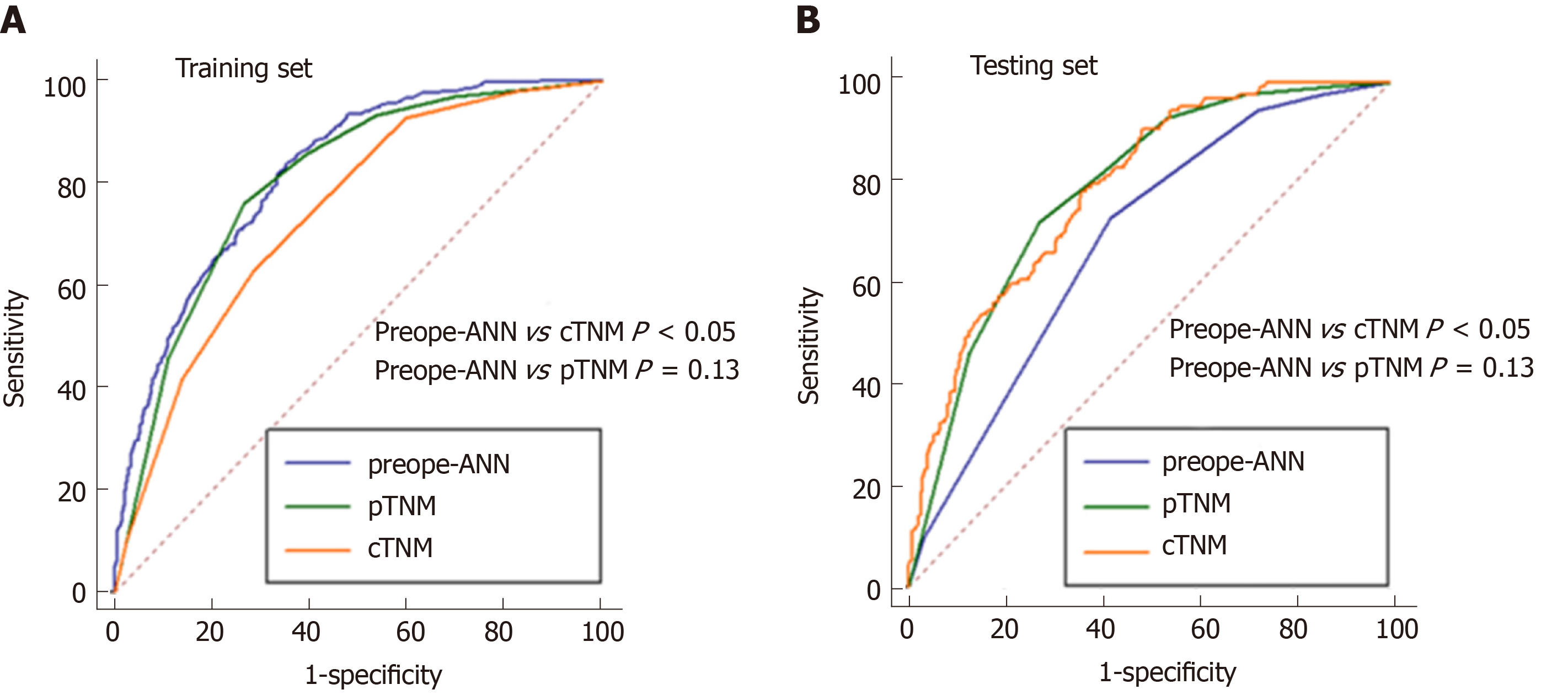Copyright
©The Author(s) 2019.
World J Gastroenterol. Nov 21, 2019; 25(43): 6451-6464
Published online Nov 21, 2019. doi: 10.3748/wjg.v25.i43.6451
Published online Nov 21, 2019. doi: 10.3748/wjg.v25.i43.6451
Figure 1 Structure diagram of the preoperative artificial neural network model.
Age, sex, body mass index, American society of anesthesiologists score, tumor location, tumor size, prognostic nutrition index, albumin-globulin ratio, neutrophil-lymphocyte ratio, platelet-lymphocyte ratio, clinical T stage, clinical N stage, carcinoembryonic antigen, carbohydrate antigen 19-9, and alpha fetoprotein are the input variables. All weighted values passed to the hidden layer node are summed on the hidden layer node and passed to the output node through the sigmoid function. All weighted values entering the output node are summed again and passed through the sigmoid function. For each patient, the probability of output is 0-1.0. In the training of the artificial neural network, the output values are compared with the real results of each patient. The weight is adjusted so that the next time the patient appears on the network, the network output is closer to the real result. NLR: Neutrophil-lymphocyte ratio; PLR: Platelet-lymphocyte ratio; AGR: Albumin-globulin ratio; PNI: Prognostic nutrition index; BMI: Body mass index; ASA: American society of anesthesiologists score; cT: Clinical T stage; cN: Clinical N stage; CEA: Carcinoembryonic antigen; CA199: Carbohydrate antigen 19-9; AFP: Alpha fetoprotein.
Figure 2 Prediction of the 3-year survival of patients using the preoperative artificial neural network.
In the training set, the predictive accuracy rate was 77.3%. The sensitivity and specificity of the centralized training model were 88.5% and 50.1%, respectively. The accuracy of the testing set model for survival prediction was 75.2%. The sensitivity and specificity of the test set model were 86.5% and 43.1%, respectively.
Figure 3 Subgroup survival curves of the preoperative artificial neural network.
A: The survival curve of each subgroup of the preoperative artificial neural network model showed good discrimination in the training and testing sets (P < 0.05). B: The survival analysis of the training set showed that the substages of the TNM system were well differentiated (P < 0.05). Preope-ANN: Preoperative artificial neural network.
Figure 4 Survival curves of the clinical TNM staging.
A: The discrimination between the survival curves of each stage of the clinical TNM (cTNM) system in the training set was good (P < 0.05). B: There was no significant difference in the survival curves between the cTNM stages I and II A (P = 0.935), and between stages III and IVA (P = 0.355). cTNM: Clinical TNM.
Figure 5 Survival curves of the pathological TNM staging.
A: In the training set, the survival curve discrimination between stages IA and IB was poor (P = 0.240), and there was no significant difference in the survival curves between stages IIA and IIB and IIB and IIIA (P < 0.05). B: In the testing set, there was no significant difference in survival curves between stages IA and IB, IIA and IIB, and IIIA and IIIB of the pathological TNM staging (P > 0.05). pTNM: Pathological TNM.
Figure 6 Comparison of the receiver operating characteristic curves among the preope-ANN model, clinical TNM stage, and pathological TNM stage.
A: In the training set, the area under the curve (AUC) values of the preoperative artificial neural network (preope-ANN) model, clinical TNM (cTNM) staging, and pathological TNM (pTNM) staging were 0.820 (0.800-0.838), 0.740 (0.718-0.762), and 0.803 (0.782-0.822), respectively. The comparison of the AUC values in the training set showed that the predictive performance of the preope-ANN was better than that of the cTNM stage (P < 0.05), and similar to that of pTNM stage (P = 0.130). B: In the testing set, the AUC values of the preope-ANN model, cTNM staging, and pTNM staging were 0.790 (0.752-0.825), 0.687 (0.644-0.727), and 0.786 (0.748-0.821), respectively. The comparison of the AUC values in the testing set showed that the prediction performance of the preope-ANN and the pTNM stage was better than that of the cTNM stage (P < 0.05), and the prediction performance of the preope-ANN was similar to that of the pTNM stage (P = 0.858). pTNM: Pathological TNM; cTNM: Clinical TNM; preope-ANN: Preoperative artificial neural network.
- Citation: Que SJ, Chen QY, Qing-Zhong, Liu ZY, Wang JB, Lin JX, Lu J, Cao LL, Lin M, Tu RH, Huang ZN, Lin JL, Zheng HL, Li P, Zheng CH, Huang CM, Xie JW. Application of preoperative artificial neural network based on blood biomarkers and clinicopathological parameters for predicting long-term survival of patients with gastric cancer. World J Gastroenterol 2019; 25(43): 6451-6464
- URL: https://www.wjgnet.com/1007-9327/full/v25/i43/6451.htm
- DOI: https://dx.doi.org/10.3748/wjg.v25.i43.6451














